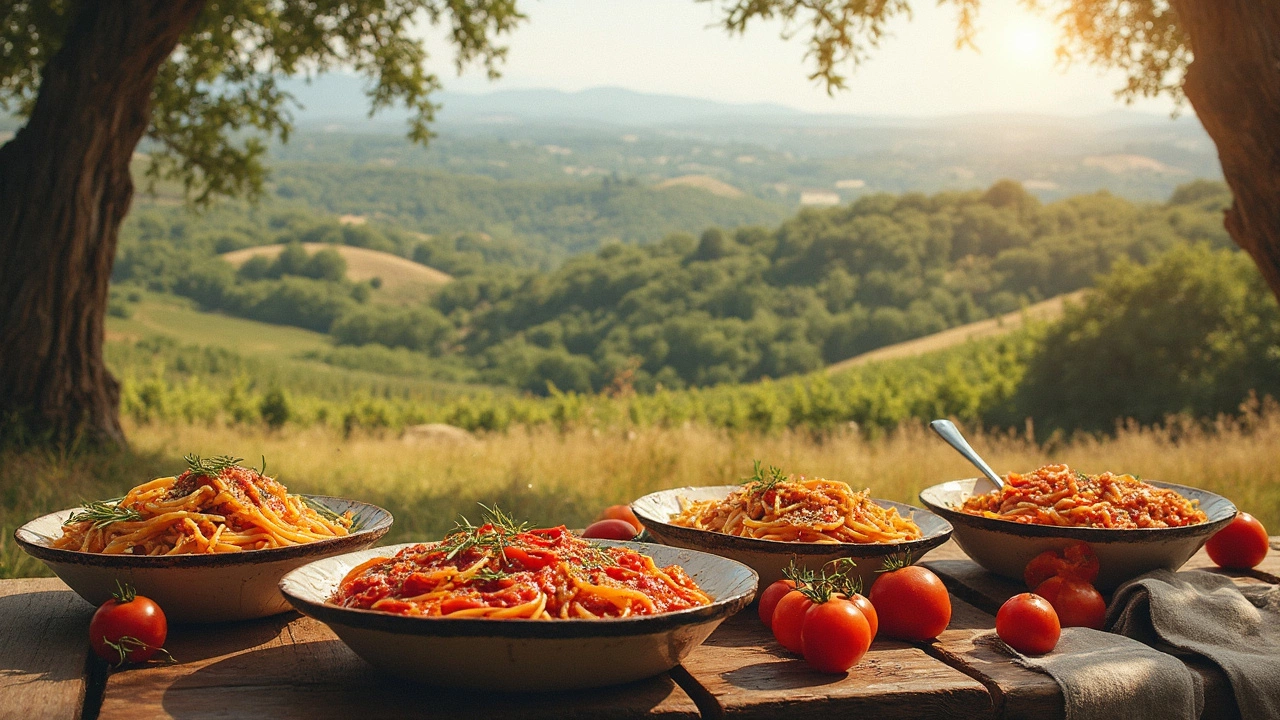Have you ever found yourself in a heated debate over whether true Italian sauce includes onions? You're not alone. This culinary question has sparked more than a few discussions amongst pasta enthusiasts. Some purists argue that authentic Italian tomato sauce should be free of onions, while others swear by it.
The truth? It depends on who you ask and where in Italy you're standing. In Northern Italy, you'll find onions frequently used to add sweetness and depth to sauces. Meanwhile, down in the Southern parts, onion might not even make it to the dance.
But don't stress if you're a fan of adding the occasional onion to your pot. Italian cooking is all about personal and regional expression. So what's more important is to understand what version of pasta sauce speaks to you.
- The Role of Onions in Italian Sauces
- Regional Variations and Traditions
- When to Include and When to Skip
- Tips for Creating Authentic Italian Flavors
The Role of Onions in Italian Sauces
Ever wondered why we throw onions into our pasta sauces? It all comes down to flavor. When onions cook, they release sugars that add a natural sweetness, balancing out the acidity of tomatoes. This trick is especially beloved in Northern Italy, where you'll find onions sneaking into several classic recipes. In fact, they're a staple in hearty Bolognese, which wouldn't be the same without them.
Breaking Down Onion Varieties
You might think an onion is just an onion, but oh, how wrong you'd be! Different types bring unique flavors to the table. The common yellow onion is a go-to for its blend of sweetness and bite, making it suitable for most sauces. Red onions add a bit of extra color and mildness, while white onions are often sharper, frequently featured in Southern Italian cuisine where less is more.
Onions: Yay or Nay?
So, should you throw onions in every sauce pot? Not necessarily. Some dishes, like the traditional Southern Italian Sugo al Pomodoro, often skip onions altogether, preferring garlic for aromatics. Meanwhile, in a classic soffritto—a mix of onion, celery, and carrot used as a base for many Italian sauces—onions are indispensable.
It's really about personal preference and the specific dish you're making. If you're a fan of Northern flavors, don't skimp on the onions. For more Southern-inspired dishes, a lighter touch or even skipping them can be the key.
| Sauce Type | Onion Use |
|---|---|
| Bolognese | Yes |
| Sugo al Pomodoro | No |
| Ragu | Yes |
| Marinara | Maybe |
Regional Variations and Traditions
Italy isn't just one homogenous food hub; it’s a tapestry of flavors, especially when it comes to beloved pasta sauce. Italians treasure their culinary traditions, and each region brings its own twist to the table. Let's dig into how different areas handle the question of onions in their sauce.
North vs. South Italy
In Northern Italy, particularly places like Lombardy and Veneto, onions are a staple in their base sauces. They often start with a 'soffritto,' a blend of minced onions, carrots, and celery simmered in olive oil, forming a flavor-rich foundation for dishes like Bolognese.
Down South, in the sun-soaked areas like Naples and Sicily, you'll notice a lean towards simpler preparations—often focusing on tomatoes, garlic, and basil. Here, sauces rely more on the natural sweetness of ripe tomatoes, making onions less common.
The Influence of Tradition
Tradition influences decision-making in the kitchen, quite profoundly in Italy. In a family-run trattoria, recipes might have been passed down for generations, and deviations from traditional methods are rare. If Nonna didn't use onions, then neither does anyone else in the family.
But, as globalization brings diverse tastes to the fore, some chefs and home cooks are experimenting. A small tweak can result in a sauce that appeals to new palates while honoring old-school techniques.
A Quick Tip for Home Cooks
Whether you stand by using onions in your sauce or not, you might want to play around with onion alternatives such as shallots, which are milder and often favored in Liguria. Cooking is as much about experimenting as it is about sticking to tradition!
Those little quirks in recipes reflect centuries of changing landscapes, economies, and tastes. Embracing these regional distinctions can elevate your pasta night from mundane to memorable.

When to Include and When to Skip
Deciding whether to include onions in your Italian sauce depends on a few key considerations. It's not a one-size-fits-all answer, and understanding the dish and its origins can guide your choice.
Consider the Recipe Origin
First off, think about the regional recipe you're crafting. In the north of Italy, particularly in regions like Emilia-Romagna, onions are often part of the foundational mirepoix, which includes celery and carrots. Here, onions provide a subtle sweetness and complexity that complements rich, meat-based sauces like Bolognese.
| Region | Common Ingredients |
|---|---|
| Northern Italy | Onions, garlic, meats |
| Southern Italy | Garlic, herbs, sometimes onions |
Conversely, if you're whipping up a traditional Roman Amatriciana or Arrabbiata, onions might be left out, allowing garlic and chili flakes to take the spotlight. These dishes focus on bold flavors, where onions might not be necessary.
Flavor Profile and Personal Preference
Think about the kind of flavor profile you want. Want something sweet and mellow? Stir in those onions. If you're after a more assertive, aromatic hit, garlic might be your best bet, leaving onions aside.
- For rich, meat-heavy sauces: include onions for depth.
- For spicy, garlic-forward dishes: skip the onions.
- Personal preference: it's your kitchen, after all. If you love onions, go for it!
Cooking Techniques
If you decide to use onions, how you cook them matters. Sauté them slowly over low heat to caramelize and bring out natural sugars. This can tame their sharpness and add layers of flavor.
Practical Tip for a Balanced Sauce
Sometimes balance is key. Consider using a combo of onions and garlic for a well-rounded flavor. Many home cooks find that using shallots—somewhere between an onion and garlic—can be the perfect middle ground.
Tips for Creating Authentic Italian Flavors
When it comes to crafting that perfect Italian sauce, authenticity is key. Let's talk about some practical tips to help you nail those Italian flavors like a pro. Whether you add onions or not, these insights will level up your pasta game.
Use Fresh Ingredients
It all starts with what you're putting in the pot. Fresh tomatoes, quality olive oil, and herbs straight from the garden are non-negotiables. If you can't get fresh, opt for good canned tomatoes, preferably San Marzano. They bring a sweetness and richness you can’t beat.
Simplicity Over Complexity
Authentic Italian cooking isn't about a laundry list of ingredients. It's about letting each component shine. As Italian chef Massimo Bottura once said,
"The essence of an Italian dish lies in the simplicity of its preparation."Let the flavors of your core ingredients do the talking.
Sautéing Your Base
Whether you're team onion or not, sautéing your aromatics is crucial. This could be garlic, onions, or both. Cook them gently in olive oil until they're tender, releasing their natural oils. This forms a flavorful foundation for your sauce.
Balance Your Flavors
The balance between acidity, sweetness, and saltiness is fundamental. Always taste as you go and adjust with a pinch of sugar or salt if needed. Including a dash of red wine can round out and deepen the sauce flavor in a way nothing else can.
Let It Simmer
Once your tomatoes and aromatics are mixed, let it simmer. Most Italians will let their sauce bubble away gently, infusing all those flavors. Remember, patience makes perfect.
| Ingredient | Recommended Quantity |
|---|---|
| Fresh Tomatoes | 2 lbs |
| Olive Oil | 3 tbsp |
| Garlic Cloves | 2-3, minced |
| Salt | To taste |
Following these tips doesn't just bring you closer to the taste of Italy; it's a journey in understanding the significance of tradition. Whether you opt for or against onions, the heart of your sauce remains authentic.

